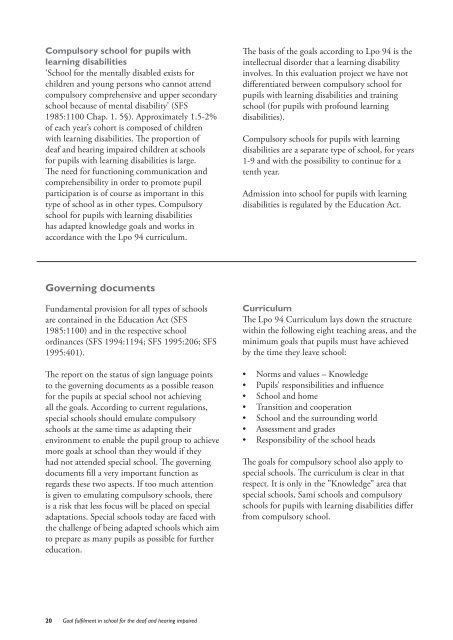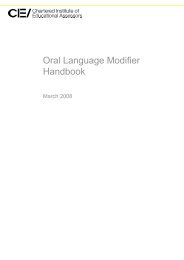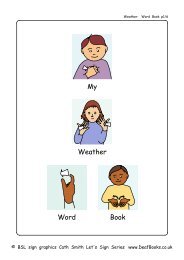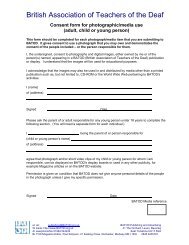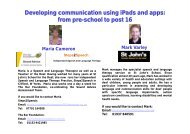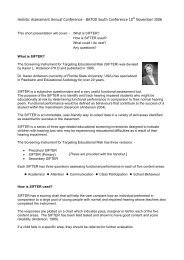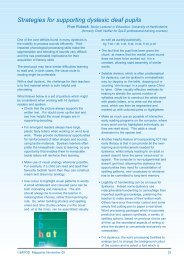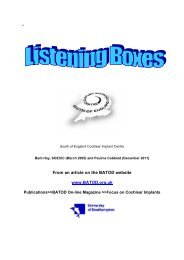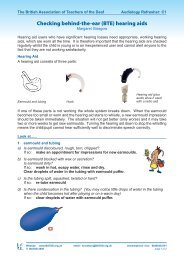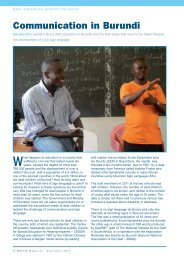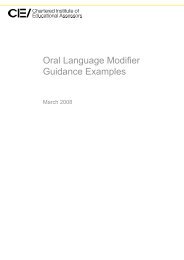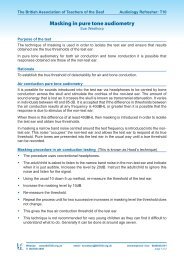Goal fulfilment in school for the deaf and hearing impaired - batod
Goal fulfilment in school for the deaf and hearing impaired - batod
Goal fulfilment in school for the deaf and hearing impaired - batod
- No tags were found...
You also want an ePaper? Increase the reach of your titles
YUMPU automatically turns print PDFs into web optimized ePapers that Google loves.
Compulsory <strong>school</strong> <strong>for</strong> pupils withlearn<strong>in</strong>g disabilities‘School <strong>for</strong> <strong>the</strong> mentally disabled exists <strong>for</strong>children <strong>and</strong> young persons who cannot attendcompulsory comprehensive <strong>and</strong> upper secondary<strong>school</strong> because of mental disability’ (SFS1985:1100 Chap. 1. 5§). Approximately 1.5-2%of each year’s cohort is composed of childrenwith learn<strong>in</strong>g disabilities. The proportion of<strong>deaf</strong> <strong>and</strong> hear<strong>in</strong>g <strong>impaired</strong> children at <strong>school</strong>s<strong>for</strong> pupils with learn<strong>in</strong>g disabilities is large.The need <strong>for</strong> function<strong>in</strong>g communication <strong>and</strong>comprehensibility <strong>in</strong> order to promote pupilparticipation is of course as important <strong>in</strong> thistype of <strong>school</strong> as <strong>in</strong> o<strong>the</strong>r types. Compulsory<strong>school</strong> <strong>for</strong> pupils with learn<strong>in</strong>g disabilitieshas adapted knowledge goals <strong>and</strong> works <strong>in</strong>accordance with <strong>the</strong> Lpo 94 curriculum.The basis of <strong>the</strong> goals accord<strong>in</strong>g to Lpo 94 is <strong>the</strong><strong>in</strong>tellectual disorder that a learn<strong>in</strong>g disability<strong>in</strong>volves. In this evaluation project we have notdifferentiated between compulsory <strong>school</strong> <strong>for</strong>pupils with learn<strong>in</strong>g disabilities <strong>and</strong> tra<strong>in</strong><strong>in</strong>g<strong>school</strong> (<strong>for</strong> pupils with profound learn<strong>in</strong>gdisabilities).Compulsory <strong>school</strong>s <strong>for</strong> pupils with learn<strong>in</strong>gdisabilities are a separate type of <strong>school</strong>, <strong>for</strong> years1‐9 <strong>and</strong> with <strong>the</strong> possibility to cont<strong>in</strong>ue <strong>for</strong> atenth year.Admission <strong>in</strong>to <strong>school</strong> <strong>for</strong> pupils with learn<strong>in</strong>gdisabilities is regulated by <strong>the</strong> Education Act.Govern<strong>in</strong>g documentsFundamental provision <strong>for</strong> all types of <strong>school</strong>sare conta<strong>in</strong>ed <strong>in</strong> <strong>the</strong> Education Act (SFS1985:1100) <strong>and</strong> <strong>in</strong> <strong>the</strong> respective <strong>school</strong>ord<strong>in</strong>ances (SFS 1994:1194; SFS 1995:206; SFS1995:401).The report on <strong>the</strong> status of sign language po<strong>in</strong>tsto <strong>the</strong> govern<strong>in</strong>g documents as a possible reason<strong>for</strong> <strong>the</strong> pupils at special <strong>school</strong> not achiev<strong>in</strong>gall <strong>the</strong> goals. Accord<strong>in</strong>g to current regulations,special <strong>school</strong>s should emulate compulsory<strong>school</strong>s at <strong>the</strong> same time as adapt<strong>in</strong>g <strong>the</strong>irenvironment to enable <strong>the</strong> pupil group to achievemore goals at <strong>school</strong> than <strong>the</strong>y would if <strong>the</strong>yhad not attended special <strong>school</strong>. The govern<strong>in</strong>gdocuments fill a very important function asregards <strong>the</strong>se two aspects. If too much attentionis given to emulat<strong>in</strong>g compulsory <strong>school</strong>s, <strong>the</strong>reis a risk that less focus will be placed on specialadaptations. Special <strong>school</strong>s today are faced with<strong>the</strong> challenge of be<strong>in</strong>g adapted <strong>school</strong>s which aimto prepare as many pupils as possible <strong>for</strong> fur<strong>the</strong>reducation.CurriculumThe Lpo 94 Curriculum lays down <strong>the</strong> structurewith<strong>in</strong> <strong>the</strong> follow<strong>in</strong>g eight teach<strong>in</strong>g areas, <strong>and</strong> <strong>the</strong>m<strong>in</strong>imum goals that pupils must have achievedby <strong>the</strong> time <strong>the</strong>y leave <strong>school</strong>:•••••••Norms <strong>and</strong> values – KnowledgePupils’ responsibilities <strong>and</strong> <strong>in</strong>fluenceSchool <strong>and</strong> homeTransition <strong>and</strong> cooperationSchool <strong>and</strong> <strong>the</strong> surround<strong>in</strong>g worldAssessment <strong>and</strong> gradesResponsibility of <strong>the</strong> <strong>school</strong> headsThe goals <strong>for</strong> compulsory <strong>school</strong> also apply tospecial <strong>school</strong>s. The curriculum is clear <strong>in</strong> thatrespect. It is only <strong>in</strong> <strong>the</strong> ”Knowledge” area thatspecial <strong>school</strong>s, Sami <strong>school</strong>s <strong>and</strong> compulsory<strong>school</strong>s <strong>for</strong> pupils with learn<strong>in</strong>g disabilities differfrom compulsory <strong>school</strong>.20 <strong>Goal</strong> <strong>fulfilment</strong> <strong>in</strong> <strong>school</strong> <strong>for</strong> <strong>the</strong> <strong>deaf</strong> <strong>and</strong> hear<strong>in</strong>g <strong>impaired</strong>


